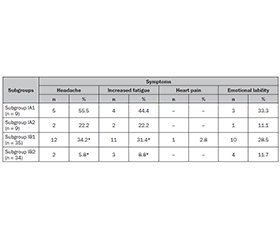Журнал «Здоровье ребенка» Том 19, №1, 2024
Вернуться к номеру
Лікування порушень моторної функції верхніх відділів травного тракту в дітей із вегетативною дисфункціє
Авторы: Y.V. Karulina, T.I. Shevtsova
Bogomolets National Medical University, Kyiv, Ukraine
Рубрики: Педиатрия/Неонатология
Разделы: Клинические исследования
Версия для печати
Актуальність. Останнім часом відмічається зростання поширеності вегетативної дисфункції (ВД) та на її фоні — порушень моторної функції верхнього відділу травного каналу (ВВТК), що є основою для формування хронічної патології органів травлення в дітей. Мета: удосконалити лікування дітей із ВД шляхом вивчення виду порушень моторної функції ВВТК та призначення схем терапії залежно від типу розладів моторики. Матеріали та методи. У статті наведено результати клініко-анамнестичного, лабораторного, інструментального та психологічного дослідження 109 дітей віком 6–16 років з вегетативною дисфункцією. Результати. Усі обстежені були поділені на дві репрезентативні групи: основну (група І, n = 87) — діти із синдромом ВД і порушеннями моторної функції ВВТК, які за типом останньої були розділені на дві підгрупи: ІА — з прискоренням цієї функції (n = 18) та ІВ — з її уповільненням (n = 69); групу порівняння (група ІІ, n = 22) — діти із синдромом ВД без розладів моторної функції ВВТК. З метою проведення лікування підгрупу ІА, у свою чергу, було поділено на дві терапевтичні підгрупи: ІА1 — тільки базисна терапія синдрому ВД та ІА2 — крім базисної терапії синдрому ВД, проводили корекцію порушень моторної функції ВВТК. Пацієнти підгрупи ІВ також були поділені на дві підгрупи: ІВ1 — тільки базисна терапія синдрому ВД та ІВ2 — крім базисної терапії синдрому ВД, виконували корекцію порушень моторики ВВТК. Доведено ефективність лікування синдрому вегетативної дисфункції з урахуванням типу моторних розладів ВВТК. Були запропоновані різні схеми лікування дітей із ВД без порушень функції ВВТК та з наявністю розладів моторики. Застосування в комплексній терапії дітей із синдромом вегетативної дисфункції препаратів, що впливають на моторну функцію верхнього відділу травного каналу, вірогідно підвищує її ефективність при лікуванні протягом 30 днів (89,0 проти 57,0 % при уповільненні моторної функції). Висновки. Доведено ефективність комплексного лікування вегетативної дисфункції з урахуванням типу моторних розладів ВВТК, що вірогідно знижує ризик виникнення рецидивів патології органів травлення в дітей.
Background. Recently, there has been an increase in the prevalence of the autonomic nervous system (ANS) dysfunction and, against this background, motility disorders of the upper digestive tract (UDT), which, in turn, is the basis for the formation of chronic pathology of the digestive organs in children. The purpose was to improve the treatment of children with ANS dysfunction by studying the type of motility disorders of the UDT and prescribing therapy schemes depending on the type of disorders. Materials and methods. The article presents the results of clinical and anamnestic, laboratory, instrumental and psychological research of 109 children aged 6–16 years with autonomic dysfunction. Results. All surveyed children were divided into two representative groups: group I (main one, n = 87) — patients with autonomic dysfunction and impaired motility of the UDT who by type of motor function were divided into two subgroups: IA — with the acceleration of this function (n = 18) and IB — with its slowdown (n = 69); group II (comparison one, n = 22) — children with autonomic dysfunction without motility disorders of the UDT. In order to treat patients in subgroup IA, they, in turn, were divided into two therapeutic subgroups: IA1 — only basic therapy for autonomic dysfunction, and IA2 — in addition to basic therapy for autonomic dysfunction, correction of motility disorders of the UDT was performed. Patients of subgroup IB were also divided into two subgroups: IB1 — only basic therapy for autonomic dysfunction, and IB2 — in addition to basic therapy for autonomic dysfunction, correction of motility disorders of the UDT was conducted. The effectiveness of treatment for autonomic dysfunction syndrome has been proven, taking into account the type of motility disorders of the UDT. Different treatment regimens were proposed for children with ANS dysfunction without disorders and with the presence of motility disorders. The use in the comprehensive treatment of children with autonomic dysfunction syndrome of drugs that affect the motor function of the upper alimentary canal significantly increases its effectiveness during treatment for 30 days (89.0 versus 57.0 % when motor function slows down). Conclusions. The effectiveness of the comprehensive treatment for autonomic dysfunction has been proven, taking into account the type of motility disorders of the UDT. It reliably reduces the risk of recurrence of clinical manifestations of gastrointestinal pathology in children.
вегетативна дисфункція; рухова функція; діти
autonomic dysfunction; motor function; children

